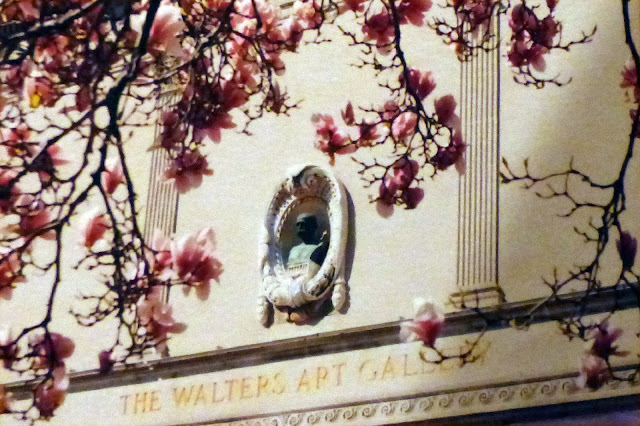This 1907 bust of William T. Walters by William Henry Rinehart stands in a niche high above the front door of the Walters Art Gallery in Baltimore Maryland.
“WALTERS, wâl'terz, William Thompson, American merchant and art collector: b. on the Juniata River, Pa., 23 May 1820; d. Baltimore, Md., 22 Nov. 1894. He was educated as a civil engineer, but became interested in the coal and iron industry, and while in charge of a smelting establishment in Pennsylvania produced the first iron manufactured from mineral coal in the United States. He removed to Baltimore in 1841, and established himself as a wine merchant there in 1847. He was president of the first steamship line between Baltimore and Savannah and was one of the reorganizers of the Southern lines. In 1861-65 he resided in Europe, where he traveled widely in the interest of art, and purchased numerous additions for his collection. He was United States commissioner at the Paris expositions of 1867 and 1878, and also to that at Vienna in 1873. His private collection was one of the largest and most valuable in the United States, and his annual exhibit of his gallery for charity netted $30,000 for the poor of Baltimore. He wrote ‘Barye’ (1885); ‘Notes Upon Certain Masters of the 19th Century’ (1886), etc.” -- Encyclopedia Americana
The Smithsonian gives a simple description of what we see here.
A bust of William Thompson Walters is installed in an elaborate, circular niche on the façade of the gallery. The bust depicts Walters with a moustache.
The bronze bust is based on this 1867 marble bust found in the Walters Art Museum.
The Museum label tells the story.
BUST OF WILLIAM T. WALTERS,
probably modeled 1860, carved 1866-67
William Henry Rinehart
American, 1825—74
In 1907 a bronze, over-life-size version of this portrait of William T. Walters was commissioned by his son Henry Walters to decorate the façade of his newly completed palazzo-style art gallery facing Charles Street (see photo). This building, which forms the older part of the present-day museum, was constructed to house the art collection that his father had begun 50 years earlier.
He was no dreamer, yet amid life's hasteDared follow where the high ideals led;His largess made the wide world less a waste,Art's path less hard to tread.
Read the poem, “William T Walters: Obiit 22 November MDCCCXCIV” as it appeared in Modern Art, Vol. 3, No. 1 Winter 1895.
For a more prosaic obituary see the New York Times.








No comments:
Post a Comment